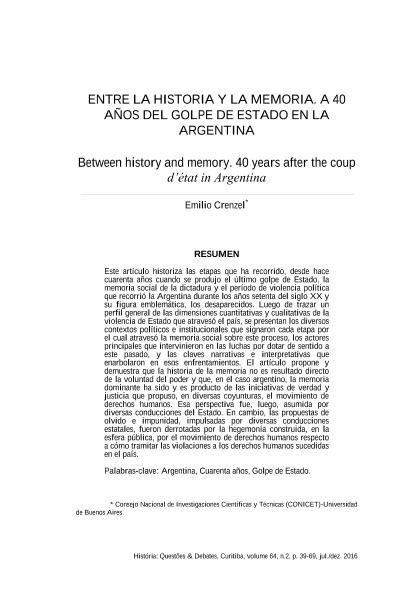Artículo
Este artículo historiza las etapas que ha recorrido, desde hace cuarenta años cuando se produjo el último golpe de Estado, la memoria social de la dictadura y el período de violencia política que recorrió la Argentina durante los años setenta del siglo XX y su figura emblemática, los desaparecidos. Luego de trazar un perfil general de las dimensiones cuantitativas y cualitativas de la violencia de Estado que atravesó el país, se presentan los diversos contextos políticos e institucionales que signaron cada etapa por el cual atravesó la memoria social sobre este proceso, los actores principales que intervinieron en las luchas por dotar de sentido a este pasado, y las claves narrativas e interpretativas que enarbolaron en esos enfrentamientos. El artículo propone y demuestra que la historia de la memoria no es resultado directo de la voluntad del poder y que, en el caso argentino, la memoria dominante ha sido y es producto de las iniciativas de verdad y justicia que propuso, en diversas coyunturas, el movimiento de derechos humanos. Esa perspectiva fue, luego, asumida por diversas conducciones del Estado. En cambio, las propuestas de olvido e impunidad, impulsadas por diversas conducciones estatales, fueron derrotadas por la hegemonía construida, en la esfera pública, por el movimiento de derechos humanos respecto a cómo tramitar las violaciones a los derechos humanos sucedidas en el país. This article historicizes the stages, since the last coup d’état, of the construction of the social memory of the dictatorship and the period of political violence of 1970s Argentina and its emblematic figure, the disappeared. It begins with a general outline of the quantitative and qualitative dimensions of the state violence that affected the country during this process, and goes on to examine the various political and institutional contexts that marked each stage of the social memory of these processes, the actors engaged in the struggles to give meaning to that past, and the key narrative and interpretative strategies deployed in such confrontations. The article proposes and demonstrates that the history of the social memory of the human rights abuses is not a direct result of the will of the power and. On the contrary, in the case of Argentina, the dominant memory has been and is a product of the initiatives of truth and justice proposed, at various junctures, by the human rights movement. That perspective was then taken over by various state governments. Instead, the proposals of forgetfulness and impunity, launched by several state governments were defeated by the hegemony built, in the public scenario, by the human rights movement regarding how to deal with human rights violations occurred in the country.
Entre la historia y la memoria: A 40 años del golpe de Estado en la Argentina
Título:
Between history and memory: 40 years after the coup d’état in Argentina
Fecha de publicación:
12/2016
Editorial:
Universidade Federal do Paraná. Programa de Pós-Graduação em História
Revista:
História Questoes e Debates
ISSN:
0100-6932
e-ISSN:
2447-8261
Idioma:
Español
Tipo de recurso:
Artículo publicado
Clasificación temática:
Resumen
Palabras clave:
Argentina
,
Aniversario
,
Golpe de Estado
,
Memoria
Archivos asociados
Licencia
Identificadores
Colecciones
Articulos(SEDE CENTRAL)
Articulos de SEDE CENTRAL
Articulos de SEDE CENTRAL
Citación
Crenzel, Emilio Ariel; Entre la historia y la memoria: A 40 años del golpe de Estado en la Argentina; Universidade Federal do Paraná. Programa de Pós-Graduação em História; História Questoes e Debates; 64; 2; 12-2016; 39-69
Compartir
Altmétricas




